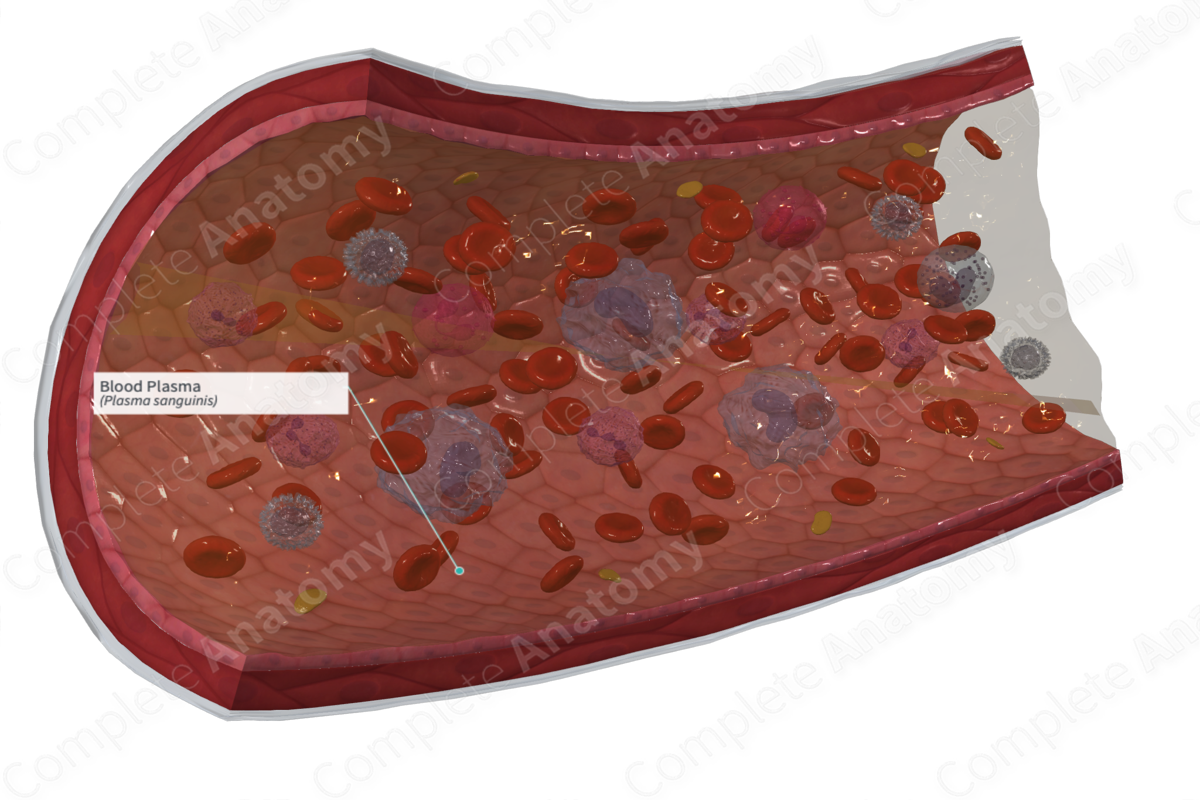
Quick Facts
Plasma is the fluid portion of the blood in which the particulate components are suspended. Plasma is to be distinguished from serum, which is the cell-free portion of the blood from which the fibrinogen has been separated in the process of clotting (Dorland, 2011).
Composition
The blood plasma is the liquid component of the blood. It’s a straw-colored sticky fluid that constitutes 55% of blood’s volume. Ninety percent of the blood plasma is composed of water, while the remaining 10% is made up of molecules, such as nutrients, salts, respiratory gases, hormones and plasma proteins (Reece et al., 2014). The blood plasma contains ions such as sodium, magnesium, chloride, calcium, phosphate, potassium, and bicarbonate; nutrients such as sugars, amino acids, and lipids; waste products such as urea, carbon dioxide, and ammonia; hormones, vitamins, oxygen, and proteins such as albumin, fibrinogen globulins and prothrombin (Reece et al., 2014). Albumins account for 60% of all plasma proteins (Silverthorn et al., 2013).
Function
The blood plasma suspends the formed elements (erythrocytes, leukocytes, and platelets) of the blood. It acts as a buffer between cells and the external environment (Silverthorn, 2016). The components of the blood plasma along with the blood cells are responsible for osmoregulation, transportation of molecules, and immune defense.
The water of blood plasma functions as a solvent. Blood electrolytes such as sodium, magnesium, chloride, calcium, phosphate, potassium, and bicarbonate are inorganic salts that are found as dissolved ions in the blood plasma. Blood electrolytes function to buffer the blood and maintain its pH at approximately 7.4. Ions in the blood plasma are involved in maintaining the blood’s osmotic balance, regulation of the cell’s membrane permeability, and muscle and nerve activity (Reece et al., 2014).
The plasma proteins primarily help maintain the osmotic balance between the blood and the interstitial fluid by acting as buffers against pH changes (Reece et al., 2014). They’re also involved in coagulation and defense against foreign invaders. They act as carriers and transport iron, steroid hormones, cholesterol, and drugs (Silverthorn et al., 2013).
—Albumin prevents water from diffusing out of the bloodstream into the extracellular matrix of the surrounding tissues. Albumin functions as a carrier protein. It binds and transports hormones such as thyroxine, metabolites, such as bilirubin, and drugs, such as barbiturates (Pawlina, 2016).
—Fibrinogen is the largest plasma protein that is involved in the process of blood clotting. It’s a clotting factor that helps plug leaks when a blood vessel is injured (Marieb, Wilhelm and Mallatt, 2012).
—Globulins are blood proteins and antibodies. Blood proteins transport lipids, copper, and iron whereas antibodies bind antigens and mark them for phagocytosis by the T lymphocytes (Marieb, Wilhelm and Mallatt, 2012).
—Apolipoprotein is a blood plasma protein that binds lipids to transport them in the blood as they are insoluble in water (Reece et al., 2014).
—Prothrombin is a plasma protein and the inactive form of thrombin. Thrombin is a protein that converts fibrinogen into fibrin that will form a blood clot during coagulation.
—Transferrin is an iron-transporting blood protein that binds iron and carries it throughout the body (Silverthorn et al., 2013).
References
Dorland, W. (2011) Dorland's Illustrated Medical Dictionary. 32nd edn. Philadelphia, USA: Elsevier Saunders.
Marieb, E. N., Wilhelm, P. B. and Mallatt, J. (2012) Human Anatomy. 14th edn.: Benjamin Cummings.
Pawlina, W. 2016. Histology: A text and atlas with correlated cell and molecular biology. 7th ed. Philadelphia: Wolters Kluwer.
Reece, J. B., Meyers, N., Urry, L. A., Cain, M. L., Wasserman, S. A., Minorsky, P. V., Jackson, R. B., Cooke, B. and Campbell, N. A. (2014) Campbell Biology. Pearson.
Silverthorn, D. U., Johnson, B. R., Ober, W. C., Garrison, C. W. and Silverthorn, A. C. (2013) Human Physiology: An Integrated Approach. Pearson Education.
